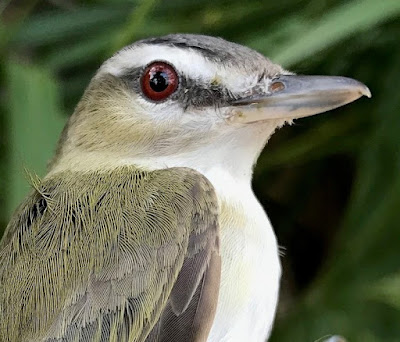Captain Sam's:
After yesterday's cold front, we were anticipating that today would be busy. However, we heard very few nocturnal flights calls overhead as we were opening the nets, and activity around the banding station at dawn was eerily quiet. Fortunately, the birds started to move around soon after and we ended up with 180 new birds and 2 recaptures. The day's catch was dominated by Common Yellowthroats. In fact, they made up 53% of everything that we banded today. Species diversity was low with only 15 species however we did get a couple first-of-the-season Palm Warblers.
We have been catching a good number of Red-eyed Vireos since the beginning of the season. A couple weeks ago, I captured an adult that had a molt limit within the greater coverts and within the alulas. Red-eyed Vireo are one of the few species that will suspend their molt on the breeding grounds and finish it after they arrive at their wintering grounds. This got me thinking that I might be able to age these adults more accurately than just assigning them to AHY (after hatch-year). I began studying the molt pattern on many of the adult Red-eyed Vireos that were coming through the station and realized that some birds could be aged as SY (second-year) and ASY (after second-year). AHY basically means a bird that is at least 1 year old and includes both SY and ASY under its classification.
HATCH-YEAR (hatched this summer - immature)
SECOND-YEAR (hatched last summer and bred this summer)
AFTER SECOND-YEAR (at least 2 years old)
_______________________________________________________
Little Bear:
Although we weren't as busy as Captains Sams (they caught more Common Yellowthroats then we had total birds!) it was still an awesome morning at Little Bear. All of us were excited for a birdy day with some first-of-season species, and things got rolling quickly with our first Veery and Eastern Wood-Pewee of the season.
 |
| Veery |
 |
| Eastern Wood-Pewee |
 |
| Palm Warbler (photo by Nate Watkins) |
 |
| Immature Mourning Warbler- similar to Common Yellowthroat at first glance, but note the pale throat and bright yellow belly. |
| Species | Captain Sam's | Little Bear | ||
|---|---|---|---|---|
| New | Recaps | New | Recaps | |
Eastern Wood-Pewee | - | - | 1 | - |
Acadian Flycatcher | 1 | - | - | - |
White-eyed Vireo | 2 | - | 2 | - |
Red-eyed Vireo | 19 | - | 17 | - |
Carolina Chickadee | - | - | - | 1 |
Veery | 2 | - | 1 | - |
Yellow-breasted Chat | - | - | 1 | - |
Ovenbird | 1 | - | - | - |
Northern Waterthrush | 13 | - | 6 | - |
Black-and-white Warbler | 2 | - | 2 | - |
Prothonotary Warbler | - | - | 1 | - |
Mourning Warbler | - | - | 1 | - |
Common Yellowthroat | 95 | - | 37 | - |
Hooded Warbler | 2 | - | - | - |
American Redstart | 21 | - | 7 | - |
Cape May Warbler | - | - | 1 | - |
Yellow Warbler | 1 | - | - | - |
Black-throated Blue Warbler | 6 | - | 2 | - |
'Western' Palm Warbler | 2 | - | 2 | - |
Prairie Warbler | 10 | - | 2 | - |
Painted Bunting | 1 | 2 | 2 | 1 |
| Today's Banding Stats | Captain Sam's | Little Bear | TOTAL |
|---|---|---|---|
| # Birds Banded | 180 | 85 | 265 |
| # of Recaptures | 2 | 2 | 4 |
| # of Species | 15 | 17 | 21 |
| Effort (net-hours) | 197.5 | 145.5 | 343 |
| Capture Rate (birds/100 net-hours) | 92.2 | 59.8 | 78.4 |
| # of Nets | 30 | 23 | - |
| 2021 Fall Cumulative Banding Stats | Captain Sam's | Little Bear | TOTAL |
|---|---|---|---|
| # Birds Banded | 635 | 376 | 1,011 |
| # of Recaptures | 132 | 53 | 185 |
| # of Species | 39 | 37 | 46 |
| Effort (net-hours) | 3,394.0 | 1,986.9 | 5,380.9 |
| Capture Rate (birds/100 net-hours) | 22.6 | 21.6 | 22.2 |
| # of Days | 25 | 20 | - |
Banding Staff








No comments:
Post a Comment